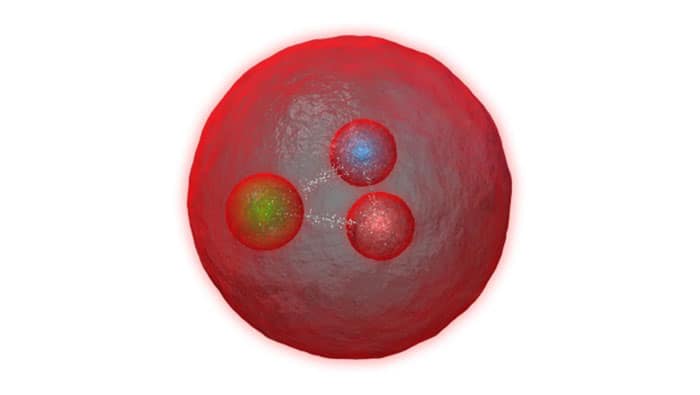The domain of particle physics often stirs a sense of wonder, merging the realms of the minuscule and the magnificent. Among the myriad of particles orchestrating the dance of matter, baryons make a vital contribution. They serve as the bedrock of atomic nuclei, and yet, the complexities underlying their compositions continue to pique the curiosity of physicists worldwide. The recent observation of the first doubly charmed baryon by the LHCb experiment marks a significant milestone in the exploration of this facet of the subatomic world.
The LHCb (Large Hadron Collider beauty) experiment is instrumental in investigating the properties of beauty and charm quarks, which are fundamental constituents of baryons. Baryons, characterized by their tri-quark structure, include nucleons such as protons and neutrons, as well as more exotic configurations. The doubly charmed baryon, known as ( Xi_{cc}^{++} ), consists of two charm quarks and one light quark, thus exhibiting unusual characteristics that distinguish it from its lighter counterparts.
The allure of the doubly charmed baryon extends beyond its unique makeup; it serves as an empirical manifestation of quantum chromodynamics (QCD), the theory that describes the strong force interactions among quarks and gluons. Understanding its properties yields insights into the underlying mechanisms that govern particle interactions at high energies. Researchers have frequently noted that the existence of baryons with multiple heavy quarks challenges longstanding theoretical assumptions, particularly those surrounding the stability and formation of such particles within the confines of the strong force.
Observations of the ( Xi_{cc}^{++} ) were achieved by meticulous analyses of collision data collected at CERN’s Large Hadron Collider. The LHC operates at energy levels previously unattainable, facilitating rare processes that produce particles like the doubly charmed baryon. When protons collide at such prodigious energies, they create an environment where short-lived particles can emerge and emanate detectable signatures before decaying into lighter baryons and mesons.
The intrinsic characteristics of the ( Xi_{cc}^{++} ) facilitate its detection. Its relatively large mass, approximately 3.5 GeV/c², positions it within the threshold accessible at the LHC, while its decay channels provide observable pathways for study. Through careful scrutiny of decay products, researchers identified the signature of the doubly charmed baryon, thereby affirming its existence. This identification not only contributes to the particle inventory but also aids in refining the theoretical frameworks that underpin baryon formation.
The discovery of the ( Xi_{cc}^{++} ) spurs inquiries into the implications of its existence on the broader field of baryon spectroscopy and multiquark states. It ignites discussions on particle classification schemes and challenges pre-existing paradigms regarding quark confinement and binding energies. The theoretical framework supports not only the existence of the doubly charmed baryon but raises tantalizing questions about the potential for even more exotic configurations. Could there exist baryons with three charm quarks, or possibly with additional quark flavors?
Moreover, this breakthrough illuminates the patterns of hadron formation and decay, offering a platform for comprehending how quarks interact at various energy scales. These interactions, governed by the elementary forces of nature, become especially fascinating when considering their roles in the early universe, possibly illustrating how baryons emerged from the primordial soup post-Big Bang. With each new quark configuration unearthed, scholars endeavor to reconstruct a clearer picture of the universe’s formative years.
The societal and cultural ramifications of such discoveries are profound. The realm of particle physics, often seen as disparate from daily human experience, impacts both technology and philosophy. Advances in understanding the fundamental components of matter can percolate through to practical applications, from medical imaging technologies to quantum computing. Furthermore, as more exotic baryons are uncovered, they inspire future generations to grapple with existential inquiries about the universe, fundamentally altering our perception of reality.
Furthermore, the intricate nature of the doubly charmed baryon challenges researchers to refine their experimental techniques and theoretical models. Collaborative efforts among physicists worldwide invigorate the discourse surrounding quark interactions and encourage interdisciplinary dialogues. As investigations into baryons expand, the convergence of particle physics and advanced technologies may render new methodologies for probing the fabric of the cosmos.
The discovery at the LHCb is not merely an endpoint but a launchpad for further investigation. Enthusiasts of physics avidly anticipate subsequent experiments which could enhance the understanding of heavy baryons and quark dynamics. The ( Xi_{cc}^{++} ) stands as a testament to the persistence of human curiosity and the insatiable desire to fathom the complexities of nature.
In summation, the first observation of the doubly charmed baryon by the LHCb offers a fertile ground for exploration and dialogue in particle physics. It invites profound considerations of theoretical implications, experimental methodologies, and philosophical inquiries. As the scientific community delves deeper into the intricacies of these exotic configurations, a richer understanding of the universe’s constituents and their interactions will inevitably unfurl, providing insight into the enigmatic tapestry of nature’s fundamental building blocks.












